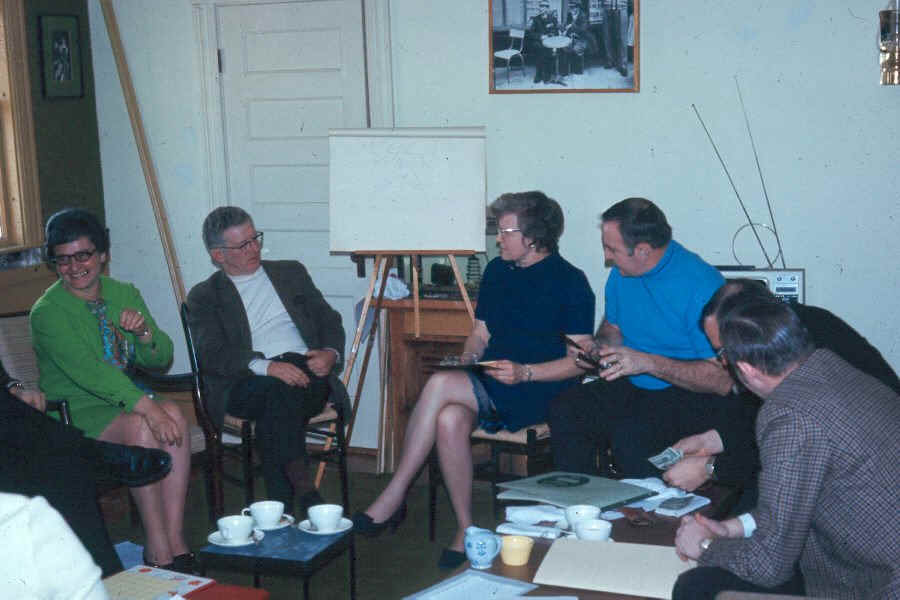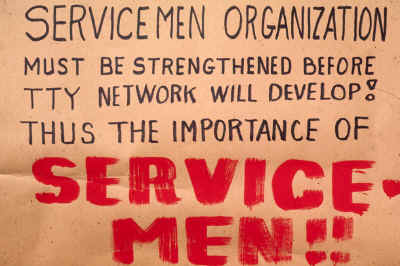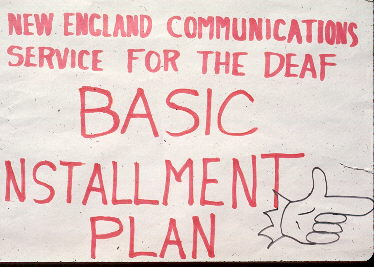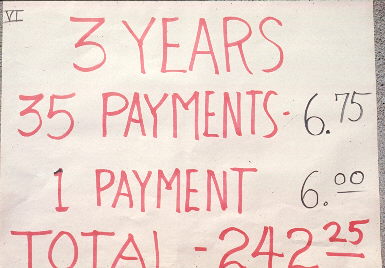|
1st NECSD ANNUAL
REPORT
First Annual Report of the New England Communications Service for the Deaf, Inc. (December 1970). |
|
| HISTORY
- New England
Communications Service
for the Deaf, Inc.
From the day Alexander Graham Bell invented the telephone while experimenting on devices to enable deaf people to hear until the year 1964, deaf people have been unable to take advantage of the telephone by themselves. It is quite ironical that the device invented by Dr. Bell was an attempt to create some sort of hearing aid for the deaf. The telephone has become a vital and accepted mode of communications between people at distances from each other; but until recently, remained useless to the deaf. Then in 1963, Mr. Robert H. Weitbretch of California, a deaf research physicist with Stanford Research Institute of Menlo Park, developed an interface unit that is used between a telephone and a teletypewriter, enabling visual printed communications between people. This interface unit, initially called a "terminal unit", is now known as PHONETYPE, and is trade-marked as such. Mr. Weitbretch, together with Dr. James C. Marsters and Mr. Andrew Saks, both of whom are deaf, formed a company, Allied Communications Corporation, to produce thesePHONETYPES commercially. Now, with over 1,000 PHONETYPES installed through-out the country, it is imperative that some sort of organization be formed to service a New England network.Thus the New England Communications Service for the Deaf, Inc., was formed on January 1970 at Tom Rule's home. NECSD's main function is to obtain used and/or discarded teletype (TTY) machines of the 5-level code, 60-words per minute type, recondition these machines to utilize the PHONETYPE and a cradle box for the handset, install these TTYs and PHONETYPES in subscribers' homes and provide necessary technical servicing for the New England regional TTY network. NECSD also has several other purpose~, which are listed elsewhere in this Annual Report. A Massachusetts charter has been drawn up by a lawyer, Mr. Frederick Conroy, who has kindly donated his services for this necessary document. Father John Fitzpatrick has been very helpful in the establishment of NECSD as a non-profit organization, and continues to exhibit strong interest in the deaf. At this time, agents for the New England area are Tom Rule, George Ecker, George Clapp and Edward Buell. Eventually, it is hoped that there will be additional agents, each servicing their own areas throughout the network.Officers elected are Tom Rule as President, George Ecker as Vice President, Jim Emery as Treasurer and Elizabeth Emery as Secretary, with Board of Director members being George Clapp, Father John Fitzpatrick and Joel Ziev. Several Board meetings have been held, furthering discussions and plans for bettering communications among the deaf and their friends in the hearing world. The First Regional TTY Workshop and Conference was held on April 11, 1970 at the John F. Kennedy School of Religion in Lexington, Mass. This occasion enabled everyone attending to become more knowledgeable of NECSD's aims and functions. Various TTYs were displayed and tried out, a demonstration of TTY maintenance and functions were given by the two Georges (Clapp and Ecker), followed by a discussion of the basic theory of PHONETYPE and TTY by Tom Rule. The general meeting covered an introduction of officers to the meeting, a description of NECSD's goals and current situations, the announcement of a financial plan for future purchasers, and a general discussion of communications. It was felt that much good came out of this meeting, and that more can be done to help all deaf people. In September, 1970 Tom Rule inaugurated the DEAF MESSENGER, which is an information center announcing news, social gatherings, meetings, religious activities all relating to the deaf world. This service is revised on a weekly basis, and is put on tape for automatic rapid transmission to any TTY subscriber calling that number at any time of the day or night. While the information is of regional interest, calls from California and St. Louis have been made to obtain this information, which attests to the national interest that deaf people have in other deaf of the United States. In November, 1970, it was voted by the Board of Directors that NECSD join the Massachusetts Council of Organizations Serving the Deaf (MASS COSO) and the Connecticut Council of Organizations Serving the Deaf (CONNCOSD) as a member of each, with Tom Rule as MASS COSO representative and George Ecker as CONNCOSD representative. The TTY network was involved recently in an attempt to arouse more support for the House Bill 4600, which has to do with the Court providing interpreters for the deaf to those deaf people appearing in Court. Time was very short, but thanks to the TTY network, it was possible to inform many TTY subscribers, and through them, other deaf, of the urgent need to secure more support by requesting everyone to -immediately write to their own representatives in the Massachusetts House of Representatives, urging them to support Bill 4600 when it came onto the floor. In the meanwhile, this Bill was still in the Ways and Means Committee, and word came that there was a possibility that the Bill would be killed in Committee, thus preventing it from appearing on the floor. Again, the network was used to immediately spread the alarm and start up petitions, etc. Within the time involved, none of this activity could have been possible without the scope and range of this TTY network under NECSD. In this day and age of technological advancement, the deaf are finally arriving at a place whereby they can begin to make themselves heard and their needs known to others besides themselves. It is up to all of us to maintain and improve this precarious position in communications, ever seeking ways to continually strive for better utilization of existing and future methods of communications with everyone, deaf and hearing alike.
IN ADDITION .... To reconditioning TTYs and servicing, NECSD's other purposes:
• R G A N I Z A T ION S For the benefit of those who would like to know about the organizations serving the deaf in the New England area, the following is a functional listing: (* means the organization is a member of MASSCOSD) Communications Network: * New England Communications Service for the Deaf, Inc. Social and Recreational
Groups: * Boston Oral Club Fall River Association of the Deaf Holyoke Athletic & Social Club * Mohawk Oral Club (Springfield) * Quincy Deaf Club * Worcester Deaf Club
Alumni Associations: Senior Deaf Citizens: Parent Groups: Special Schools: Citizens Planning Group: Resource Agency: Professional Community
Agencies: Educators: Massachusetts Association of Educators of the Hearing Impaired
NOTE the
original document has this error In September, 1960 Tom Rule inaugurated the DEAF MESSENGER, which is an information center announcing news, social gatherings, meetings, religious activities all relating to the deaf world. This is impossible of course as that would be before the group existed text here was changed to.... In September, 1970 Tom Rule inaugurated the DEAF MESSENGER, which is an information center announcing news, social gatherings, meetings, religious activities all relating to the deaf world.
This document from
the Paul and Sally Taylor Collection at SMECC.
See all the testimonials for the TTY like
this one from Tom Rule

Photo ca. 1970 From the Tom Rule Collection at SMECC
Ruth Ecker George Clapp Elizabeth Emery James Emery ? ?
Wife of TDI agent
TDI
agent
Security
Treasurer
|
















